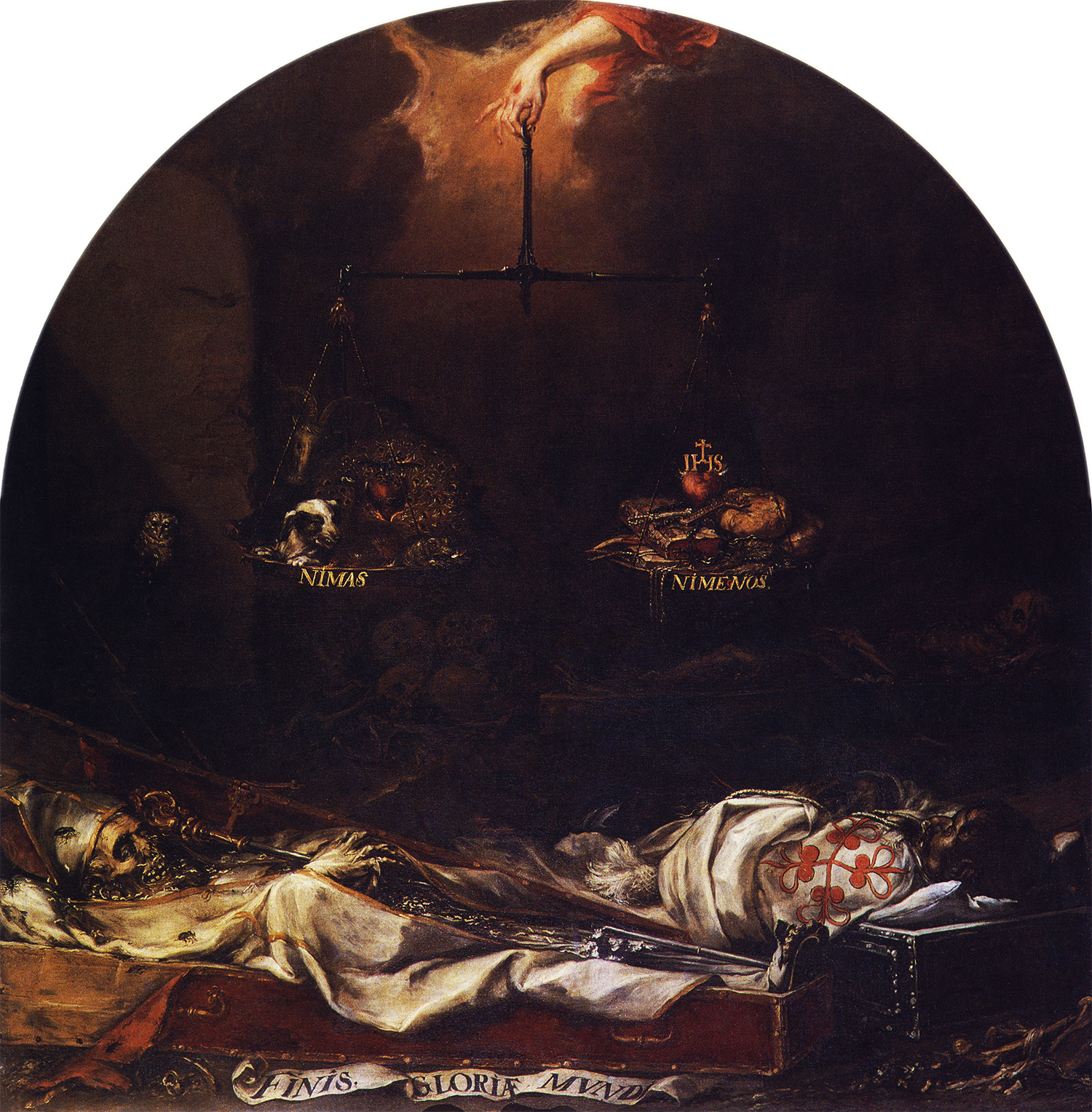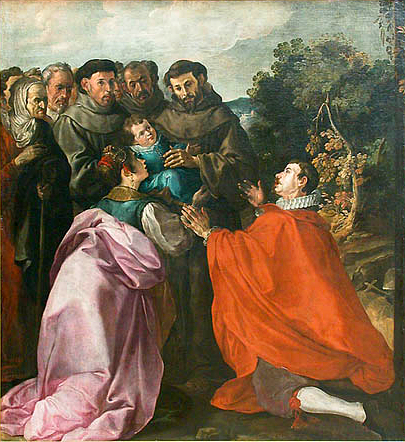|
Academia De Bellas Artes (Seville)
The Academia de Bellas Artes or Academy of Fine Arts of Seville was an institution for the instruction of students into the diverse arts. It was founded on January 1, 1660, upon the encouragement of Bartolomé Esteban Murillo, its first president. Murillo was able to also obtain the support of Juan de Valdés Leal, the second president and the younger Francisco de Herrera for this association, and the first meeting was attended by Herrera, Murillo, Valdés Leal, Sebastian Llanos y Valdes, Pedro Honorio de Palencia, Cornelio Schut, Ignacio de Iriarte, Matias de Arteaga, Matias de Carbajal, Antonio de Lejalde, Juan de Arenas, Juan Martinez, Pedro Ramirez, Bernabé de Ayala, Carlos de Negron, Pedro de Medina, Bernardo Arias Maldonado, Diego Diaz, Antonio de Zarzoza, Juan Lopez Carrasco, Pedro de Camprobin, Martin de Atienza, Alonso Perez de Herrera. :"The duties of the presidents, who revolved their position on alternate weeks, were to direct the progress of the pupils, resolve the ... [...More Info...] [...Related Items...] OR: [Wikipedia] [Google] [Baidu] |
Bartolomé Esteban Murillo
Bartolomé Esteban Murillo ( , ; late December 1617, baptized January 1, 1618April 3, 1682) was a Spanish Baroque painter. Although he is best known for his religious works, Murillo also produced a considerable number of paintings of contemporary women and children. These lively realistic portraits of flower girls, street urchins, and beggars constitute an extensive and appealing record of the everyday life of his times. He also painted two self-portraits, one in the Frick Collection portraying him in his 30s, and one in London's National Gallery portraying him about 20 years later. In 2017–18, the two museums held an exhibition of them. Childhood Murillo was probably born in December 1617 to Gaspar Esteban, an accomplished barber surgeon, and María Pérez Murillo. He may have been born in Seville or in Pilas, a smaller Andalusian town. It is clear that he was baptized in Santa Maria Magdalena, a parish in Seville in 1618. After his parents died in 1627 and 1628, he became ... [...More Info...] [...Related Items...] OR: [Wikipedia] [Google] [Baidu] |
Juan De Valdés Leal
Juan de Valdés Leal (4 May 1622 – 15 October 1690) was a Spanish painter and etcher of the Baroque era. Career Valdés was born in Seville in 1622. He became a painter, sculptor, and architect. By his twenties, he was studying under Antonio del Castillo in Córdoba. Among his works are ''History of the Prophet Elias'' for the church of the Carmelites; ''Martyrdom of St. Andrew'' for the church of San Francesco in Córdoba; and ''Triumph of the Cross'' for la Caridad in Seville. He became friends with Bartolomé Esteban Murillo, who had a very different style; Leal tended to paint somber and dramatic subjects, while Murillo's style was peaceful and serene. After Leal returned to Seville in 1656, he and Murillo founded the Seville Academy of Art. Several of his paintings treat the subjects of vanitas, transience and mortality. Two examples are ''In ictu oculi'' ("in the blink of an eye") and '' Finis gloriae mundi'' ("end of the world's glory"), painted for the Charity H ... [...More Info...] [...Related Items...] OR: [Wikipedia] [Google] [Baidu] |
Francisco De Herrera
Francisco Herrera (1576–1656) was a distinguished Spanish painter, born in Seville. He was the founder of the Seville school. Biography Francisco Herrera was born in Seville in 1576. Francisco Pacheco was his teacher, but Herrera soon broke away from the timid style and Italian traditions of Spanish painting of his day, and became the pioneer of that bold, vigorous, effective, and natural style whose preeminent exponent was Velázquez. Herrera was the first to use long brushes, which may, in part, account for his "modern" technique and dexterous brushwork. Many authorities ascribe to him the foundation of the Spanish School. His great talent brought him many pupils, whom his passionate temper and rough manners soon drove away. Velázquez, when thirteen years old, was placed under this great professor, and remained a year with him. Herrera, who was an accomplished worker in bronze, engraved medals skilfully. This gave rise to the charge of counterfeiting, and he fled for sanc ... [...More Info...] [...Related Items...] OR: [Wikipedia] [Google] [Baidu] |
Sebastian Llanos Y Valdes
Sebastian may refer to: People * Sebastian (name), including a list of persons with the name Arts, entertainment, and media Films and television * ''Sebastian'' (1968 film), British spy film * ''Sebastian'' (1995 film), Swedish drama film * ''Sebastian'' (2017 film) * ''Belle and Sebastian'' (Japanese TV series), a 1981 anime series based on the 1965 novel * '' Sebastian Star Bear: First Mission'', a Dutch animated film released in 1991 * ''Sebastiane'' (1976 film), 1976 Derek Jarman film in Latin about the saint Literature * ''Sebastian'' (Bishop novel), the first novel of the ''Landscapes of Ephemera'' duology written by Anne Bishop * ''Sebastian'' (Durrell novel), the fourth volume in ''The Avignon Quintet'' series by Lawrence Durrell * ''Belle et Sébastien'', a 1965 novel and live action TV series written by Cécile Aubry * "Sebastian, or, Virtue Rewarded", the name of an unpublished poem written around 1815 by the 9-year-old Elizabeth Barrett, later famous as El ... [...More Info...] [...Related Items...] OR: [Wikipedia] [Google] [Baidu] |
Cornelio Schut
Cornelio Schut or Cornelis Schut III (alternative names: Cornelis Escut III, Cornelis Scut III, Cornelio Schut el Mozo, Cornelio Schut el joven) (c. 1629 – 1685) was a Flemish painter who was active in Seville, Spain during his entire career. He was one of the leading Flemish painters working at that time in Seville and he was very close in style to Murillo.José Luis Requena Bravo de Laguna, ''Una nueva Inmaculada de Cornelis Schut'' in: Laboratorio de Arte: Revista del Departamento de Historia del Arte, ISSN 1130-5762, n. 18, 2005, p. 221-228 Life He was born in and trained with his uncle, the prominent Antw ...[...More Info...] [...Related Items...] OR: [Wikipedia] [Google] [Baidu] |
Matias De Arteaga
Matias is a form of the given name Matthew. In List of territorial entities where German is an official language, German-speaking Europe it is most often written as Matthias. It appears in this form in Norway, Sweden, Denmark and Finland. Alternate spellings are: Mathias (other), Mathias, Mattias, Mattis, Mats (given name), Mats and Matti (given name), Matti. Matias was the same day by the Finnish-Swedish name day calendar until 1989, when it was replaced by Mattias forms and Mats. In Finland, by the end of 2009 the name has been given to about 73,160 people. In the form of Mattias to 3,683 people, in the form of Matthias to little more than 440, and in the form of Mathias a little less than 3,000. Given name *Matias Aguayo (born 1973), German-Chilean record producer *Matias Aires (1705-1763), Portuguese philosopher *Matias Albarracin (born 1979), Argentine Olympic athlete *Matias de Arteaga (1633-1704), Spanish painter *Matias Brain (born 1974), Chilean Olympic athlete *Ma ... [...More Info...] [...Related Items...] OR: [Wikipedia] [Google] [Baidu] |
Bernabé De Ayala
Bernabé de Ayala (1625-1689) was a Spanish painter. Life He was born at Jerez de la FronteraLAMAS-DELGADO, Eduardo. "Le peintre Bernabé de Ayala et autres petits maîtres entre Séville et Cadix". ''Annales d'Histoire de l'art et d'archéologie''. XXXVI. 2014. in the beginning of the 17th century, studied under Zurbarán and imitated his manner in his tints and draperies. No doubt many of his pictures are now mistaken for the work of his master. He was one of the founders of the Academy at Seville in 1660, and was a member of it until 1671; but as his name does not appear with the subscribers to the statutes in 1673, it is supposed that his death occurred between those years. The Museum of Seville has six of his works, and there are others in the churches of that city and of Madrid Madrid ( , ) is the capital and most populous city of Spain. The city has almost 3.4 million inhabitants and a metropolitan area population of approximately 6.7 million. It is the ... [...More Info...] [...Related Items...] OR: [Wikipedia] [Google] [Baidu] |
Academia Real De Bellas Artes De San Fernando
The Real Academia de Bellas Artes de San Fernando (RABASF; ), located on the Calle de Alcalá in the heart of Madrid, currently functions as a museum and gallery. A public law corporation, it is integrated together with other Spanish royal academies in the . History The academy was established by royal decree in 1752. About twenty years later, the enlightened monarch Charles III purchased a palace in Madrid as the academy's new home. The building had been designed by José Benito de Churriguera for the Goyeneche family. The king commissioned Diego de Villanueva to convert the building for academic use, employing a neoclassical style in place of Churriguera's baroque design. The academy is also the headquarters of the Madrid Academy of Art. Notable alumni The first graduate of the academy was Bárbara María Hueva. Francisco Goya was once one of the academy's directors. Its alumni include Felip Pedrell, Pablo Picasso, Kiko Argüello, Remedios Varo, Salvador Dalí, Antoni ... [...More Info...] [...Related Items...] OR: [Wikipedia] [Google] [Baidu] |
Madrid
Madrid ( , ) is the capital and most populous city of Spain. The city has almost 3.4 million inhabitants and a metropolitan area population of approximately 6.7 million. It is the second-largest city in the European Union (EU), and its monocentric metropolitan area is the third-largest in the EU.United Nations Department of Economic and Social AffairWorld Urbanization Prospects (2007 revision), (United Nations, 2008), Table A.12. Data for 2007. The municipality covers geographical area. Madrid lies on the River Manzanares in the central part of the Iberian Peninsula. Capital city of both Spain (almost without interruption since 1561) and the surrounding autonomous community of Madrid (since 1983), it is also the political, economic and cultural centre of the country. The city is situated on an elevated plain about from the closest seaside location. The climate of Madrid features hot summers and cool winters. The Madrid urban agglomeration has the second-large ... [...More Info...] [...Related Items...] OR: [Wikipedia] [Google] [Baidu] |
Art Schools In Spain
Art is a diverse range of human activity, and resulting product, that involves creative or imaginative talent expressive of technical proficiency, beauty, emotional power, or conceptual ideas. There is no generally agreed definition of what constitutes art, and its interpretation has varied greatly throughout history and across cultures. In the Western tradition, the three classical branches of visual art are painting, sculpture, and architecture. Theatre, dance, and other performing arts, as well as literature, music, film and other media such as interactive media, are included in a broader definition of the arts. Until the 17th century, ''art'' referred to any skill or mastery and was not differentiated from crafts or sciences. In modern usage after the 17th century, where aesthetic considerations are paramount, the fine arts are separated and distinguished from acquired skills in general, such as the decorative or applied arts. The nature of art and related concepts, ... [...More Info...] [...Related Items...] OR: [Wikipedia] [Google] [Baidu] |





